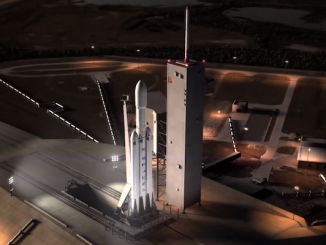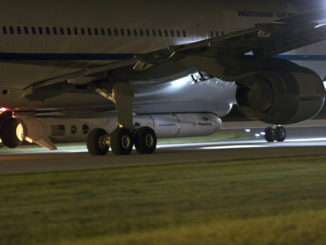EDITOR’S NOTE: Updated July 23 with orbital parameters.
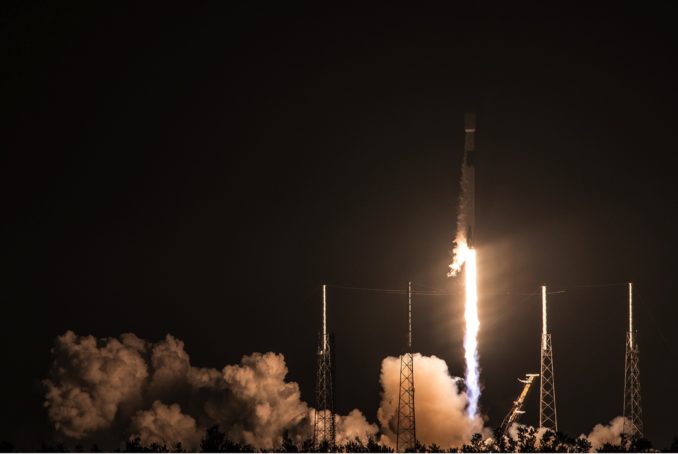
An upgraded model of SpaceX’s Falcon 9 rocket fired into orbit early Sunday from Florida’s Space Coast, hoisting a record-setting 7.8-ton (nearly 7.1-metric ton) communications satellite for Telesat toward its planned perch more than 22,000 miles over the equator.
Riding a red-hot rocket plume from its nine Merlin 1D engines, the 229-foot-tall (70-meter) Falcon 9 rocket climbed away from Cape Canaveral’s Complex 40 launch pad at 1:50 a.m. EDT (0550 GMT) Sunday.
At the tip of the rocket was the Telstar 19 VANTAGE spacecraft, a U.S.-built, Canadian-owned broadband station that set a record for the heaviest commercial communications satellite ever launched.
The Falcon 9 lit its main engines after a smooth countdown, and hold-down clamps opened to release the launcher for an on-time liftoff.
Burning a combination of kerosene and liquid oxygen, the rocket’s main engines throttled up to 1.7 million pounds of thrust to send the Falcon 9 into a starry sky, arcing to the east from Cape Canaveral over the Atlantic Ocean to dispatch the Telstar 19 VANTAGE spacecraft toward its equatorial operating orbit.
Two-and-a-half minutes after liftoff, the first stage engines shut down and the booster detached moments before the Falcon 9’s second stage engine ignited to continue the trek into space.
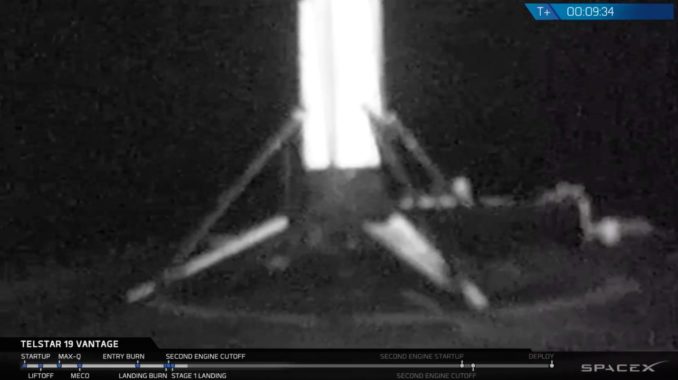
The first stage accomplished a pinpoint landing nearly nine minutes into the mission, descending to SpaceX’s drone ship “Of Course I Still Love You” parked in the Atlantic Ocean a few hundred miles east of Florida, and notching the company’s 26th successful rocket recovery. SpaceX is expected to bring the rocket back to Cape Canaveral for inspections, and will likely re-fly the booster on a future mission.
Meanwhile, the upper stage engine shut down after reaching a preliminary parking orbit. The rocket, with Telstar 19 VANTAGE still attached, coasted across the Atlantic Ocean before reigniting its upper engine over Africa for a planned 50-second firing to raise its orbit.
After a brief telemetry outage, SpaceX’s launch team confirmed the second firing of the upper stage engine nailed its objective, placing the Telstar 19 VANTAGE spacecraft into an on-target orbit.
An on-board camera showed a live view of the telecom payload separating from the upper stage nearly 33 minutes after launch, and a Telesat spokesperson confirmed ground controllers established contact with the newly-launched satellite as planned.
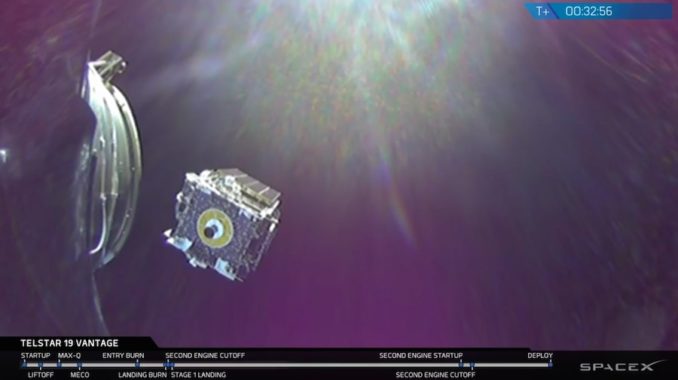
Carrying its own rocket fuel, the nearly 15,600-pound (7,075-kilogram) satellite was expected to be released into an egg-shaped transfer orbit with a perigee, or low point, a few hundred miles above Earth and an apogee, or high point, somewhere below the its final operating altitude of nearly 22,300 miles (35,800 kilometers). The spacecraft will use a hydrazine-fueled engine to finish the climb into a circular geostationary perch over the equator.
Following the company’s standard policy, SpaceX did not release the exact parameters of the orbit targeted on Sunday’s mission. Other commercial launch providers typically publish such data in advance of their missions.
U.S. military tracking data published after Sunday’s launch indicated Telstar 19 VANTAGE was released into an orbit with a perigee of 151 miles (244 kilometers), an apogee of around 11,100 miles (17,871 kilometers), and an inclination of 27 degrees to the equator.
Telecom spacecraft destined for geostationary orbit are usually deployed into elliptical transfer orbits with apogees, or high points, at or above the satellites’ final operating altitude. But the Falcon 9’s first stage keeps a fuel reserve for landing maneuvers, reducing the energy and speed it can give the rocket’s payload on ascent.
Heavy geostationary satellites launched on past Falcon 9 flights have flown on expendable versions of the SpaceX rocket, which devote all their propellant to their payloads. But the more economical alternative is to recover the rocket, restricting its ability to place a satellite into such a high-altitude orbit.
The tradeoff for satellite owners and manufacturers is they must load more fuel into their spacecraft to make up the difference.
Several satellite operators have apparently accepted the arrangement, including Telesat and the Spanish telecom company Hispasat, which agreed with SpaceX to deploy one its satellites placed into a sub-geostationary transfer orbit in March.
Telstar 19 VANTAGE should arrive in geostationary orbit within a couple of weeks, then enter service by the end of August at 63 degrees west longitude after completing tests and commissioning, along with deployments of solar panels and antennas.
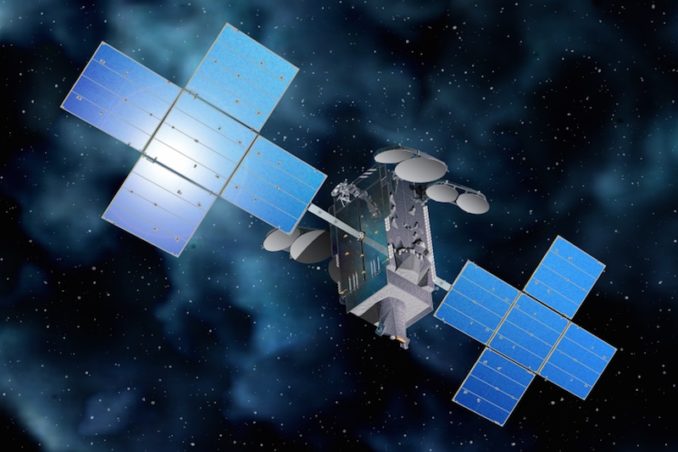
Satellites in geostationary orbit circle the planet at the same rate it rotates, keeping spacecraft in lock-step with the same geographic position. Geostationary orbit is a popular home for satellites because the orbit allows ground-based antennas to point at a constant location in the sky to link up with telecom spacecraft.
Manufactured by SSL, formerly known as Space Systems/Loral, in Palo Alto, California, the Telstar 19 VANTAGE satellite became the heaviest commercial communications satellite ever launched, eclipsing a record set by the TerreStar 1 telecom spacecraft, which weighed 15,234 pounds (6,910 kilograms) when it rode an Ariane 5 rocket into orbit July 2009.
Telstar 19 VANTAGE will operate in the same geostationary slot as the Telstar 14R satellite deployed in 2011, which encountered a failure in one of its solar arrays shortly after launch, diminishing its capability.
Telstar 19 VANTAGE carries Ku-band and Ka-band payloads, with coverage extending from Northern Canada to South America for broadband connectivity. The new satellite will also provide airborne Internet services for aircraft traveling on trans-Atlantic routes between North America and Europe, plus communications reach into the Caribbean for cruise ships and other ocean-going vessels.
“Telstar 19 VANTAGE is a state-of-the-art high-throughput satellite that will be co-located with our Telstar 14R satellite to expand our services over the Americas, the Caribbean and the North Atlantic,” said Dan Goldberg, president and CEO of Telesat. “The satellite has a mix of Ka- and Ku-band capacity.”
“The Ka-band capacity for South America is already under a 15-year contract with Hughes Network Systems and our long-standing customer Bell Canada has entered into a 15-year contract for substantially all of the satellite’s Ka-band capacity over Northern Canada, which means that all of the satellite’s Ka-band capacity serving that region is already under contract.”
Bell Canada subsidiary Northwestel, a service provider in Northern Canada, will use Telstar 19 VANTAGE’s high-throughput capacity to the territory of Nunavut.
“Making high-quality broadband services available to remote communities across the vast expanse of Canada’s north is a huge challenge,” said Curtis Shaw, chief operating officer at Northwestel, in a statement last year when Bell Canada and Telesat announced their agreement. “Northwestel looks forward to utilizing the power and capabilities of Telesat’s new state-of-the-art Telstar 19 VANTAGE satellite as part of our commitment to connect 25 communities across Nunavut to faster and more reliable broadband over the next two years.”
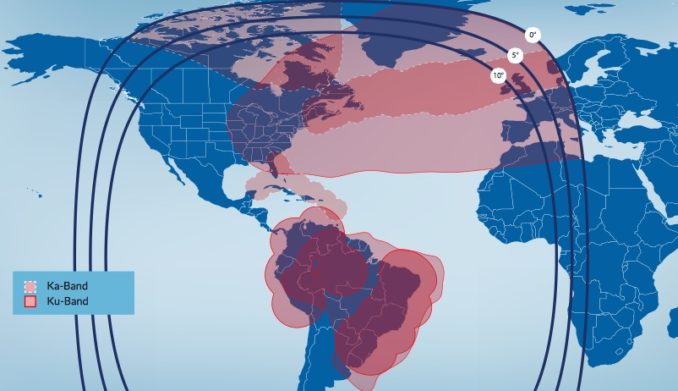
The Ka-band capacity purchased by Hughes will reach customers in Brazil, Chile, Colombia, Ecuador and Peru.
Goldberg said about a third of the new satellite’s Ku-band communications capacity has been pre-sold.
Sunday’s launch was the 58th flight of a Falcon 9 rocket since the first version of the launcher debuted in 2010, and the second Falcon 9 mission to employ all of SpaceX’s newest upgrades.
The enhanced version of the Falcon 9, known as Block 5, launched for the first time May 11. Since then, SpaceX has launched three rockets with a mix of upgraded Block 5-generation upper stages and re-flown earlier-generation first stage boosters.
The launch of Telstar 19 VANTAGE was the second time SpaceX has flown an “all-Block 5” Falcon 9 rocket, which features improvements in performance and reusability.
SpaceX ground crews at Vandenberg Air Force Base in California are readying another Falcon 9 Block 5 launcher for liftoff at 4:39 a.m. PDT (7:39 a.m. EDT; 1139 GMT) Wednesday with 10 Iridium voice and data relay satellites. Another Falcon 9 launch from Cape Canaveral is scheduled for no earlier than Aug. 2 at 1:19 a.m. EDT (0519 GMT) with Telkom Indonesia’s Merah Putih communications satellite.
That will be followed by another SpaceX launch for Telesat, carrying the Telstar 18 VANTAGE spacecraft, no earlier than Aug. 17 from Cape Canaveral.
Email the author.
Follow Stephen Clark on Twitter: @StephenClark1.

